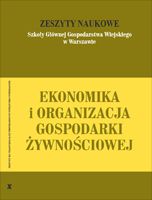Main Article Content
Article Details
ARNST R., 2009: Business as usual: Responses within ASEAN to the food crisis, Occasional paper 4, Manila: Focus on the Global South, http://focusweb.org/pdf/occasionalpaper4.pdf [dostęp: 20.12.2017].
Association of South-East Asian Nations, ASEAN, 2016: Statistical Yearbook 2016, Jakarta.
BAER-NAWROCKA A., 2014: Zmiany w spożyciu i stopniu samowystarczalności żywnościowej w Unii Europejskiej, Prace Naukowe Uniwersytetu Ekonomicznego we Wrocławiu. Agrobiznes. Problemy Ekonomiczne i Społeczne 360, 19-27.
BELESKY P., 2014: Regional Governance, Food Security and Rice Reserves in East Asia, Global Food Security 3 (3-4), 167-173, http://dx.doi.org/10.1016/j.gfs.2014.09.002
BELLO A.L., 2005: Ensuring Food Security - A Case for ASEAN Integration, Asian Journal of Agriculture and Development 2 (1-2), 87-108.
BLACK E., 2016: Got milk? Demand for Dairy Soars in Southeast Asia, http://sea-globe.com/got-milk-demand-dairy-soars-southeast-asia [dostęp: 11.11.2017].
BRIONES R.H., 2011: Regional Cooperation for Food Security: The Case of Emergency Rice Reserves in the ASEAN Plus Three, ADB Sustainable Development Working Paper Series 18, Asian Development Bank, Philippines.
CARLSON K.M., CURRAN L.M., ASNER G.P., PITTMAN A.M., TRIGG S.N., ADENEY J.M., 2012: Carbon emissions from forest conversion by Kalimantan oil palm plantations, Nature Climate Change 3 (3), 283-287, DOI 10.1038/nclimate1702
CLAPP J., 2017: Food self-sufficiency: Making sense of it, and when it makes sense, Food Policy 66, 88-96.
DAWE D., 2013: Geographic determinants of rice self-sufficiency in Southeast Asia, ESA-FAO Working Paper 13-03.
Food and Agriculture Organization UN, FAO, 2008: An Introduction to the Basic Concepts of Food Security, Food Security Information for Action. Practical Guides, EC-FAO Food Security Programme, Rome, http://www.fao.org/docrep/013/al936e/al936e00.pdf [dostęp: 11.01.2018].
Food and Agriculture Organization UN, FAO, 2017: The State of Food Security and Nutrition in the World. Building Resilience for Peace and Food Security, Rome.
GULBICKA B., 2009: Problemy wyżywienia w krajach rozwijających się, [w:] Program wieloletni 2005-2009. Ekonomiczne i społeczne uwarunkowania rozwoju polskiej gospodarki żywnościowej po wstąpieniu Polski do Unii Europejskiej, Instytut Ekonomiki Rolnictwa i Gospodarki Żywnościowej - Państwowy Instytut Badawczy, Warszawa.
GULBICKA B., KWASEK M., OBIEDZIŃSKA A., 2015: Z badań nad rolnictwem społecznie zrównoważonym (33). Analiza bezpieczeństwa żywnościowego Polski, Instytut Ekonomiki Rolnictwa i Gospodarki Żywnościowej - Państwowy Instytut Badawczy, Warszawa.
GUNARSO P., HARTOYO M.E., AGUS F., KILLEEN T., 2013: Oil Palm and Land Use Change in Indonesia, Malaysia and Papua New Guinea, Round Table on Sustainable Palm Oil (RSPO), Singapore, http://dx.doi.org/10.1787/9789264272392-en
Indonesia Investments, 2017: Rice, https://www.indonesia-investments.com/business/commodities/rice/item183? [dostęp: 12.12.2017].
Jakarta Globe, 2012: One Day No Rice to Become National Program, http://jakartaglobe.id/archive/one-day-no-rice-to-become-national-program [dostęp: 15.12.2017].
KAPUSTA F., 2016: Bezpieczeństwo żywnościowe Polski i jej mieszkańców w okresie przedakcesyjnym i po akcesji do Unii Europejskiej, Ekonomia XXI wieku 4 (12), 69-86.
KOH L.P., MIETTINEN J., LIEW S.C., GHAZOUL J., 2011: Remotely sensed evidence of tropical peatland conversion to oil palm, Proceeding of the National Academy of Sciences of the United States of America, Stanford University 108 (12), 5127-5132,https://doi.org/10.1073/pnas.1018776108
KRACIUK J., 2015: Bezpieczeństwo żywnościowe z perspektywy krajów słabo i wysoko rozwiniętych, Roczniki Naukowe Stowarzyszenia Ekonomistów Rolnictwa i Agrobiznesu 17 (3), 205-209.
KWASEK M., 2009: Tendencje w spożyciu żywności w krajach rozwijających się na tle rozwoju społeczno-gospodarczego, Publikacje Programu Wieloletniego 2005-2009 IERiGŻ 123.
LOWDER S.K., SKOET J., SINGH S., 2014: What do we really know about the number and distribution of farms and family farms worldwide?, Background Paper for The State of Food and Agriculture, ESA-FAO Working Paper 14-02.
MALCHAR-MICHALSKA D., 2012: Wpływ kryzysu żywnościowego na wykorzystanie ograniczeń eksportowych w handlu międzynarodowym surowcami rolnymi, [w:] J. Rymarczyk, M. Domiter, W. Michalczyk (red.), Handel i inwestycje w semiglobalnym otoczeniu, Prace Naukowe Uniwersytetu Ekonomicznego we Wrocławiu 267, t. 2, 33-44.
MAŁYSZ J., 2008: Bezpieczeństwo żywnościowe strategiczną potrzebą ludzkości, AlmaMer, Warszawa.
MERZĘDA-MŁYNARSKA K., 2017: Food Security Governance in the Southeast Asia Region: from National to Regional Governance, Historia i Polityka 20 (27), 31-48, http://dx.doi.org/10.12775/HiP.2017.010
MIKUŁA A., 2012: Bezpieczeństwo żywnościowe Polski, Roczniki Ekonomii Rolnictwa i Rozwoju Obszarów Wiejskich 99 (4), 38-48.
NOSECKA B., KRASOWICZ S., PAWLAK K., KITA K., ZAREMBA Ł., 2012: Czynniki konkurencyjności sektora rolno-żywnościowego we współczesnym świecie, Raport PW 54, Instytut Ekonomiki Rolnictwa i Gospodarki Żywnościowej - Państwowy Instytut Badawczy, Warszawa.
Organisation for Economic Co-operation and Development, OECD, 2017: Building Food Security and Managing Risk: A Focus on Southeast Asia, 2017, OECD Publishing, Paris.
Organisation for Economic Co-operation and Development, Food and Agriculture Organization UN, OECD-FAO, 2017: Agricultural Outlook 2017-2026, OECD Publishing, Paris.
SAPA A., 2010: Bezpieczeństwo żywnościowe w krajach rozwijających się, Roczniki Ekonomiczne Kujawsko-Pomorskiej Szkoły Wyższej w Bydgoszczy 3, 231-244.
US Department of Agriculture, USDA, 2014: International Egg And Poultry Review 17 (14), http://search.ams.usda.gov/MNDMS/2014/04/PY20140408WIntlPoultryandEgg.pdf [dostęp: 11.12.2017].
ŻYŁA A., 2013: Charakterystyka azjatyckiego modelu rozwoju gospodarczego w świetle teorii oraz doświadczeń krajów zaliczanych do pierwszej i drugiej generacji "azjatyckich tygrysów", Prace Naukowe Uniwersytetu Ekonomicznego we Wrocławiu 315, 459-470.
Downloads
- Dominika Głąbska, Monika Borowska, Dominika Guzek, Food products choices made by schoolchildren in the context of changes of the legal regulations associated with selling food products in schools , Zeszyty Naukowe SGGW - Ekonomika i Organizacja Gospodarki Żywnościowej: No. 115 (2016)
You may also start an advanced similarity search for this article.
- Walenty Poczta, Katarzyna Kita, Joanna Średzińska, The Economic Situation of Farms in the European Union Countries According to their Production Potential , Zeszyty Naukowe SGGW - Ekonomika i Organizacja Gospodarki Żywnościowej: No. 97 (2012)





